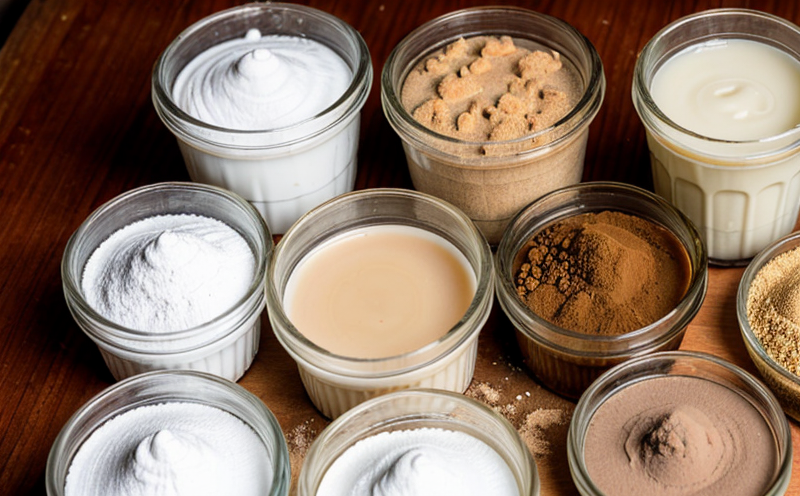USDA MLG 38.01 Detection of Spoilage Molds in Animal Feed
The USDA MLG 38.01 protocol is a critical standard for ensuring the safety and quality of animal feed by detecting spoilage molds, which can significantly impact the health and productivity of livestock. This method is essential because it helps prevent the introduction of harmful microorganisms that could lead to foodborne illnesses or reduce nutritional value in feeds.
The testing process involves several steps designed to ensure accurate detection and identification of mold species present in animal feed. Samples are first collected from various points within a batch to ensure a representative sample is analyzed. Once collected, the samples undergo initial conditioning to standardize moisture content before being plated onto specialized media that supports the growth of spoilage molds.
The plates are then incubated under controlled conditions until visible colonies form. Identification of specific mold species relies on morphological characteristics observed during microscopic examination as well as biochemical tests if necessary. This process allows for precise quantification and characterization, enabling producers to make informed decisions about potential contamination levels.
Accurate detection is paramount because spoilage molds not only pose risks to animal health but also affect feed palatability and shelf life. By adhering strictly to USDA MLG 38.01 guidelines, laboratories can provide reliable results that contribute significantly towards maintaining the integrity of the food chain from farm gate to table.
Given its importance in safeguarding both human and animal health, compliance with this standard is non-negotiable for industries dealing directly or indirectly with agricultural products. Implementing robust quality control measures through rigorous testing ensures adherence to regulatory requirements while fostering trust among consumers regarding product safety.
The method’s complexity requires expertise from experienced analysts who understand the nuances involved in sample preparation and interpretation of results. This knowledge base translates into accurate reporting which is crucial for effective decision-making processes at every level.
Why It Matters
The detection of spoilage molds in animal feed using USDA MLG 38.01 is vital because it directly impacts the health and productivity of livestock. Mold contamination can lead to numerous issues including reduced feed intake, lower weight gain rates, increased mortality rates, and compromised immune systems.
- Reduction in Feed Intake: Molds produce mycotoxins that are harmful when consumed by animals. These toxins interfere with normal digestive processes causing decreased appetite which subsequently affects overall growth performance.
- Lower Weight Gain Rates: Continuous exposure to mold-contaminated feeds results in slower weight gains compared to those fed uncontaminated diets. This translates into higher production costs for farmers.
- Increased Mortality Rates: Severe cases of mold toxicity can result in death among livestock, leading to significant economic losses for producers.
Beyond these immediate impacts on animal health and productivity, there are broader implications for public health. Consuming meat derived from animals fed moldy feeds poses risks of mycotoxin exposure which has been linked to various human diseases including cancer.
Therefore, implementing stringent quality control measures such as USDA MLG 38.01 testing becomes indispensable in ensuring the safety and efficacy of animal feed products throughout the supply chain.
Why Choose This Test
- Comprehensive Detection: The USDA MLG 38.01 protocol offers a comprehensive approach to detecting spoilage molds by incorporating both visual inspection and microbiological analysis techniques.
- Standardized Procedure: By following established standards, laboratories ensure consistent results across different batches of feed samples, enhancing reliability and accuracy.
- Expertise & Experience: Our team comprises highly skilled professionals equipped with the latest knowledge and skills required to conduct thorough analyses accurately and efficiently.
The use of advanced equipment like scanning electron microscopes (SEM) ensures precise identification down to species level, providing valuable insights into potential risks associated with particular molds found in feeds. Additionally, our comprehensive testing encompasses not only mold presence but also their levels which helps in making informed decisions regarding corrective actions needed.
Our commitment to delivering accurate and reliable results coupled with adherence to international standards such as USDA MLG 38.01 ensures that we meet or exceed expectations set by regulatory bodies and industry stakeholders alike.
International Acceptance and Recognition
The USDA MLG 38.01 method for detecting spoilage molds in animal feed enjoys widespread acceptance across global markets due to its rigorous quality control measures and consistent results. Many countries have adopted this standard as part of their own regulatory frameworks, recognizing the importance of ensuring product safety.
- Australia: The Australian Food Standards Code (Standard 1437) incorporates similar principles for assessing mold contamination in feeds intended for livestock consumption.
- Canada: Canada’s Food and Drugs Act requires compliance with relevant international standards including those aligned with USDA MLG 38.01.
- European Union: The EU Regulation (EC) No 2945/93 on animal nutrition specifies that feedstuffs must comply with specified hygiene requirements, which include adherence to methods like USDA MLG 38.01 where applicable.
Incorporating these standards into national regulations underscores the global recognition of the necessity for stringent quality assurance practices in the agriculture sector. This alignment fosters trust among consumers and enhances market access opportunities for compliant entities.
By leveraging internationally accepted protocols like USDA MLG 38.01, organizations demonstrate their commitment to maintaining high ethical standards within the industry, thereby contributing positively towards sustainable development goals.





